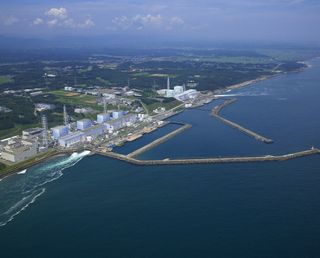Fukushima Radiation Leak: 5 Things You Should Know

Japan's nuclear regulator has raised the threat level of a radioactive leak at the crippled Fukushima Daiichi plant from 1 to 3 on a 7-point scale.
Officials said Tuesday that a storage tank has leaked 300 tons of radioactive water into the ground. The rating upgrade, which has to be confirmed by the United Nations' nuclear agency, would be the first since the March 2011 quake-induced reactor meltdown.
Here are five things to know about the leak and related radiation:
1. What does the nuclear warning level mean?
The International Nuclear and Radiological Event Scale (INES) is a rating system for describing the severity of nuclear accidents. It was introduced in 1990 by the International Atomic Energy Agency, which reports to the U.N.
The 7-point scale ranges from 1 ("Anomaly") to 7 ("Major Accident"). Japan's Nuclear Regulation Authority classified the Fukushima disaster as a level-7 event in 2011. [In Pictures: Japan Earthquake & Tsunami]
The new leak is the first to be given an INES rating since the original disaster. Initially classified as a level one ("Incident"), it has been upgraded to level three ("Serious Incident"), pending confirmation by the UN nuclear agency. A The upgrade to level 3 ("Serious Incident") means the event involves the release of "a few thousand terabecquerels of activity into an area not expected by design which requires corrective action," or one resulting in radiation rates of "greater than one sievert per hour in an operating area," according to the INES user's manual. A terabecquerel is 1 trillion becquerels, defined as the radioactive decay of one nucleus per second; a sievert is a unit of biological radiation dose equivalent to about 50,000 front view chest X-rays.
Sign up for the Live Science daily newsletter now
Get the world’s most fascinating discoveries delivered straight to your inbox.
2. How much radioactive material leaked into the ocean?
Immediately after the June 2011 meltdown, scientists measured that 5,000 to 15,000 terabecquerels of radioactive material was reaching the ocean. The biggest threat at that time was from the radionuclide cesium. But for leaks that enter the ground, the radionuclides strontium and tritium pose more of a threat, because cesium is absorbed by the soil while the other two are not.
The Tokyo Electric Power Plant (TEPCO) estimated that since the March 2011 disaster, between 20 trillion and 40 trillion becquerels of radioactive tritium have leaked into the ocean, the Japanese newspaper Asahi Shimbun reported.
The damaged plant is still leaking about 300 tons of water containing these radionuclides into the ocean every day, Japanese government officials say. An additional 300 tons have leaked into the ground from the latest storage tank leak.
3. How will the radioactive material affect sea life?
Ever since the 2011 disaster, scientists have been measuring levels of radioactivity in fish and other sea life. Several species of fish caught off the coast of Fukushima in 2011 and 2012 had cesium levels that exceeded Japan's regulatory limit for seafood, but the overall cesium levels of ocean life have dropped since the fall of 2011, U.S. and Japanese scientists both reported.
U.S. scientists say the groundwater leaks could become worse, but warn against drawing conclusions about the impacts on sea life before peer-reviewed studies are completed. "For fish that are harvested 100 miles [160 kilometers] out to sea, I doubt it’d be a problem," Nicholas Fisher, a marine biologist at Stony Brook University in Stony Brook, N.Y., told LiveScience for a previous article. "But in the region, yes, it's possible there could be sufficient contamination of local seafood, so it'd be unwise to eat that seafood," Fisher said.[7 Craziest Ways Japan's Earthquake Affected Earth]
4. What is being done to contain the leak?
Plant operators have started to remove the contaminated soil around the leaking tank, and are expected to remove any water remaining inside by the end of today (Aug. 21), NBC News reported.
But operators are concerned that other tanks may fail too. About a third of the tanks, including the one that just leaked, have rubber seams that TEPCO says were only meant to last about five years, The New York Times reported. A TEPCO spokesperson said the company plans to build additional watertight tanks with welded seams, but will still have to use the ones with rubber seams.
Cleaning up the radioactive water will take decades. Officials are considering several possible methods for preventing contaminated groundwater from reaching the ocean, including freezing the ground around the plant or injecting the surrounding sediment with a gel-like material that hardens like concrete. Ultimately, an integrated systematic water treatment plan is needed, Dale Klein, former head of the U.S. Nuclear Regulatory Commission told LiveScience for a previous article.
5. How does Fukushima compare with the Chernobyl meltdown?
The Fukushima plant's meltdown in 2011 is considered the worst nuclear disaster since the Chernobyl meltdown in Ukraine in 1986. Although both were given an INES rating of 7, far more radiation was released at Chernobyl — about 10 times as much as at Fukushima, NPR reported. And the health consequences a Fukushima to date have been much less severe.
The Chernobyl meltdown involved the explosion of an entire reactor that sent out a plume of radiation over a wide area. Many people nearby drank contaminated milk and later developed thyroid cancer.
By contrast, Fukushima's radioactive cores remained mostly protected, and much of the radioactive material has been carried out to sea, far from human populations. People in risky areas were evacuated, and contaminated food was kept out of stores. While the long-term health risks are unknown, the World Health Organization said there is very little public health risk outside of the 18-mile evacuation zone.
Follow Tanya Lewis on Twitter and Google+. Follow us @livescience, Facebook & Google+. Original article on LiveScience.

Most Popular


